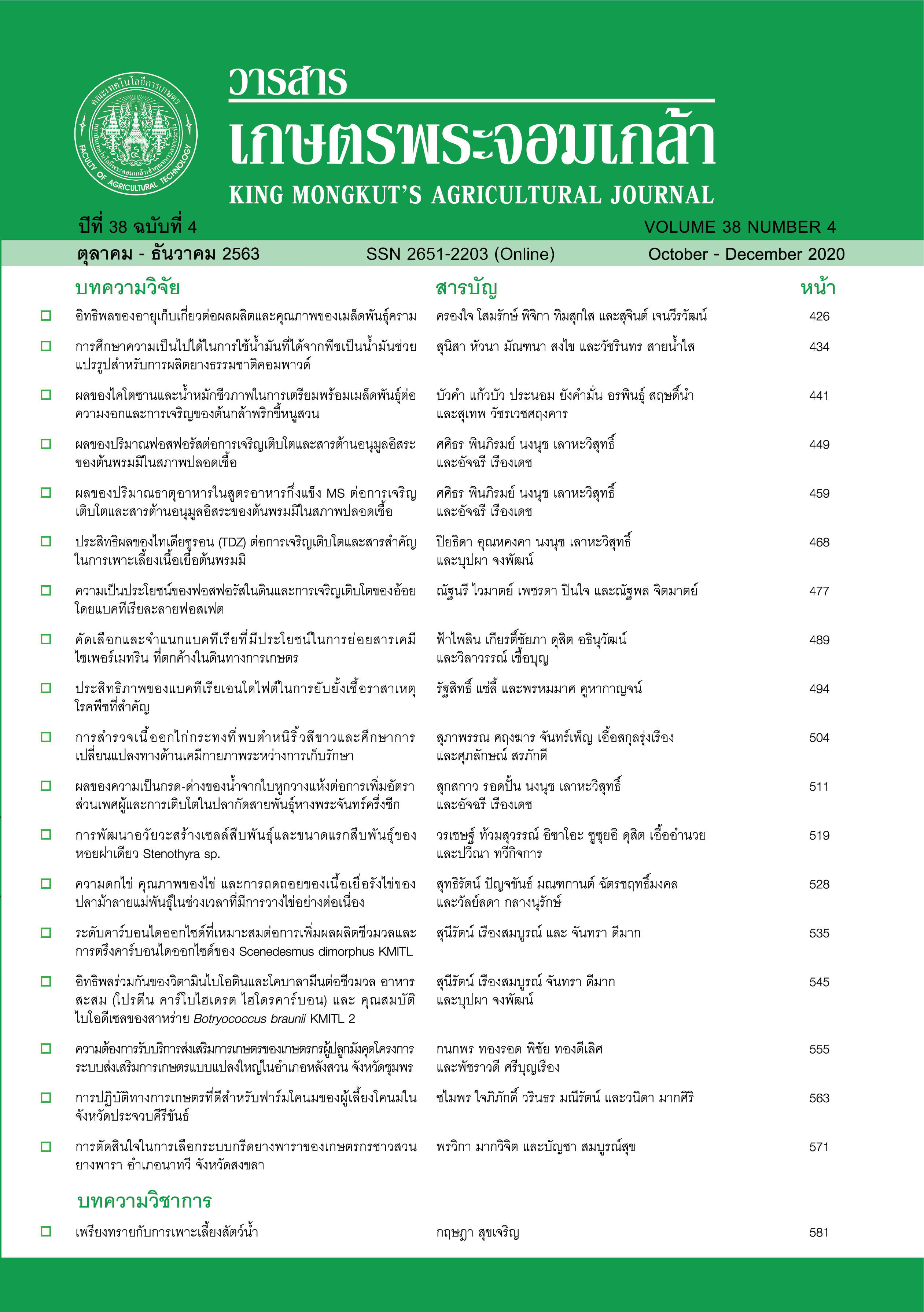ความดกไข่ คุณภาพของไข่ และการถดถอยของเนื้อเยื่อรังไข่ของปลาม้าลายแม่พันธุ์ ในช่วงเวลาที่มีการวางไข่อย่างต่อเนื่อง
Main Article Content
บทคัดย่อ
ปลาม้าลายนับว่าเป็นปลาที่มีความสำคัญทางเศรษฐกิจอย่างหนึ่ง ซึ่งนิยมนำมาเลี้ยงเป็นปลาสวยงาม ทำให้เกษตรกรต้องผสมปลาม้าลายเป็นจำนวนมากเพื่อให้เพียงพอต่อความต้องการของตลาด การผสมพันธุ์ปลาอย่างต่อเนื่องอาจทำให้แม่พันธุ์มีความเสื่อมโทรม นำไปสู่การผลิตลูกปลาที่มีคุณภาพและปริมาณที่ลดลงได้ ในการศึกษาครั้งนี้จึงได้ตรวจสอบความถดถอยของรังไข่จากแม่พันธุ์ปลาม้าลายที่มีการปล่อยไข่อย่างต่อเนื่อง โดยเปรียบเทียบความดกไข่ อัตราการผสมติด อัตราการฟักตัวออกจากไข่ของตัวอ่อน และความผิดปกติของตัวอ่อน รวมถึงตรวจสอบลักษณะทางพยาธิสภาพของเนื้อเยื่อรังไข่ ระหว่างปลาม้าลายเพศเมียที่ปล่อยไข่ครั้งแรก (กลุ่มควบคุม) กับปลาม้าลายเพศเมียที่ปล่อยไข่อย่างต่อเนื่องเป็นจำนวน 5 ครั้ง ผลการศึกษาพบว่าเมื่อปลาแม่พันธุ์ปล่อยไข่อย่างต่อเนื่องจะทำให้ความดกไข่ อัตราการผสมติด และอัตราการฟักตัวของไข่ที่ผลิตได้มีแนวโน้มลดลง จำนวนตัวอ่อนที่ผิดปกติจะมีปริมาณเพิ่มขึ้น อีกทั้งผลการศึกษาลักษณะทางพยาธิสภาพ ยังพบว่าเซลล์ไข่ในรังไข่มีการพัฒนาช้าลง ดังนั้นจากการศึกษาครั้งนี้ทำให้ทราบว่าเมื่อแม่พันธุ์ปล่อยไข่อย่างต่อเนื่อง จะทำให้เกิดความผิดปกติของเนื้อเยื่อรังไข่ ส่งผลต่อคุณภาพและปริมาณของไข่และตัวอ่อนที่ผลิตได้ ดังนั้นหลังการผสมพันธุ์แต่ละครั้งควรมีการพักปลาแม่พันธุ์ในระยะเวลาที่เหมาะสมเพื่อให้รังไข่ได้มีการฟื้นฟูสภาพก่อนการผสมพันธุ์ในครั้งต่อไป
Article Details
วารสารเกษตรพระจอมเกล้า
เอกสารอ้างอิง
Briggs, J. P. 2002. The zebrafish: A new model organism for integrative physiology. American Journal of Physiology-Regulatory Integrative and Comparative Physiology 282(1): 3-9.
Brown-Peterson, N. J., Wyanski, D. M., Saborido-Rey, F., Macewicz, B. F., and Lowerre-Barbieri, S. K. 2011. A Standardized terminology for describing reproductive development in fishes. Marine and Coastal Fisheries: Dynamics, Management, and Ecosystem Science 3: 52-70.
Clelland, E., and Peng, C. 2009. Endocrine/paracrine control of zebrafish ovarian development. Molecular and Cellular Endocrinology 312(1-2): 42-52.
Klangnurak, W., Fukuyo, T., Rezanujjaman, M. D., Seki, M., Sugano, S., Suzuki, Y., and Tokumoto, T. 2018. Candidate gene identification of ovulation-inducing genes by RNA sequencing with an in vivo assay in zebrafish. Plos One 13(5): 1-19.
Klangnurak, W., and Tokumoto, T. 2017. Fine selection of up-regulated genes during ovulation by in vivo induction of oocyte maturation and ovulation in zebrafish. Zoological Letters 3: 1-10.
Koç, N. C., Aytekin, Y., and Yüce, R. 2008. Ovary maturatıon stages and histological investigation of ovary of the Zebrafish
(Danio rerio). Brazilian Archives of Biology and Technology an International Journal 51: 512-522.
Kucharczyk, D., Stępień, P., Nowosad, J., Kupren, K., Targońska, K., and Kujawa, R. 2018. The optimization of wide-type zebrafish, Danio rerio (Hamilton, 1822) reproduction in low temperatures under controlled conditions. Turkish Journal of Fisheries and Aquatic Sciences 18: 49-55.
Silva, P, Rocha, M. J., Cruzeiro, C., Malhãoa, F., Reis, B., Urbatzka, R., Monteiro, R. A. F., and Rocha, E. 2012. Testing the effects
of ethinylestradiol and of an environmentally relevant mixture of xenoestrogens as found in the Douro River (Portugal) on
the maturation of fish gonads — A stereological study using the zebrafish (Danio rerio) as model. Aquatic Toxicology
124-125: 1-10.
Wafer, L. N., Jensen, B., Whitney, J. C., Gomez, B. H., Flores, R., and Goodwin, B. S. 2016. Effects of environmental enrichment on the fertility and fecundity of zebrafish (Danio rerio). Journal of the American Association for Laboratory Animal Science 55(3): 291-294.
Westerfield, M. 1995. The zebrafish book: a guide for the laboratory use of zebrafish (Brachydanio rerio). Eugene: University of Oregon press.


